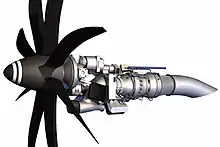Pratt & Whitney Canada
Pratt & Whitney Canada (PWC or P&WC) is a Canada-based aircraft engine manufacturer. PWC's headquarters are in Longueuil, Quebec, just outside Montreal. It is a division of the larger US-based Pratt & Whitney (P&W), itself a business unit of RTX Corporation.[2] United Technologies had given PWC a world mandate for small and medium aircraft engines while P&W's US operations develop and manufacture larger engines.
 | |
| Type | Division |
|---|---|
| Industry | Aerospace |
| Founded | November 1928 |
| Headquarters | , |
Key people | Maria Della Posta (President) |
| Owner | RTX Corporation |
Number of employees | 10,000[1] |
| Parent | Pratt & Whitney |
| Website | www |
Although PWC is a division of P&W, it does its own research, development and marketing as well as the manufacturing of its engines. The company currently has about 10,000 employees worldwide, with 6,000 of them in Canada.[1]
History
The Canadian Pratt & Whitney Aircraft Company, Ltd. was founded in November 1928 to act as a service centre for P&W aircraft engines.[3] During World War II, it assembled Pratt & Whitney Wasp series engines built in the U.S. In 1952, the production of Wasp engines was transferred to Canadian Pratt & Whitney so P&W could concentrate on developing jet engines.[4]
In the late 1950s, a team of 12 Canadian Pratt & Whitney engineers began the development of the first small turbine engine in Canada, the PT6. The first example was delivered to a customer in 1963. In 1962, the company was renamed United Aircraft of Canada (UAC), and assumed its current name in 1975.[3] In 1963 a total of 41 Sikorsky CH-124 Sea King (originally CHSS-2) helicopters were delivered to the Royal Canadian Navy. The airframe components were made in Connecticut by another United Aircraft subsidiary, Sikorsky, but most of the aircraft were assembled by UAC in Longueuil, Quebec.
Its 100,000th engine was produced in May 2017, its fleet logged 730 million flight hours and 60,000 in-service engines are operated by 12,300 customers in more than 200 countries.[5]
Products
Engines
| Model name | Configuration | Power |
|---|---|---|
| Pratt & Whitney JT12[lower-alpha 1] | Turbojet | 3,300 lbf |
| Pratt & Whitney Canada JT15D | Turbofan | 3,050 lbf |
| Pratt & Whitney Canada PT6 | Turboprop/turboshaft | 578 hp |
| Pratt & Whitney Canada PT6T | Turboshaft | 1,600 hp |
| Pratt & Whitney Canada PW100 | Turboprop | 1,800 to 5,000 hp |
| Pratt & Whitney Canada PW200 | Turboshaft | 561 hp |
| Pratt & Whitney Canada PW300 | Turbofan | 4,750 lbf |
| Pratt & Whitney Canada PW500 | Turbofan | 2,887 lbf |
| Pratt & Whitney Canada PW600 | Turbofan | 900 lbf |
| Pratt & Whitney Canada PW800 | Turbofan | 15,429 lbf |
| Pratt & Whitney Canada PW900 | APU family[6] | |
Next Generation Regional Turboprop

By 2017, PWC was developing a new engine, the Next Generation Regional Turboprop, scalable from 4,500 to 8,000 shp (3,400 to 6,000 kW) for 90-seaters and featuring a new compressor, state-of-the-art propeller and nacelle among technologies, materials and manufacturing processes improvements to deliver 20% better fuel efficiency and 20% less maintenance costs than the PW100.[7][8] The high-efficiency compressor testing began in 2012 and ran the full range of aerodynamic design points to validate the component efficiency and pressure ratio.[9] Compressor tests were successfully completed in 2016 and Hot-section technology was to be adapted from the PW1000G. PWC targeted 2023-25 for its introduction, and it was to halve operating cost per shaft horsepower.[10]
Aircraft
- Sikorsky CH-124 Sea King - primary assembly
Fleet
As of February 2023, Pratt & Whitney Canada has the following aircraft registered with Transport Canada and operate as ICAO airline designator PWC, and telephony PRATT.[11][12]
- Boeing 747SP - 2
- Cessna 560XLS - 1
- De Havilland Canada Dash 8 - 1
- Dornier 328JET (328-300) - 1
References
Footnotes
- Transferred to the American parent company, following initial design.
Notes
- "Corporate Profile: Fast Facts". About P&WC. Pratt & Whitney Canada. Retrieved 26 September 2013.
- "Fast Facts". Pratt & Whitney. Archived from the original on 22 June 2007. Retrieved 8 September 2021.
- Leyes II, Richard A.; William A. Fleming (1999). The History of North American Small Gas Turbine Aircraft Engines. Washington, DC: Smithsonian Institution. pp. 433–434. ISBN 1-56347-332-1.
- "Pratt & Whitney Canada". Canadian Business Resource. Archived from the original on 11 August 2019. Retrieved 8 September 2021.
- "Pratt & Whitney Canada Produces 100,000th Engine: Demonstrates Continued Focus on Driving Innovation" (Press release). Pratt & Whitney Canada. 2 May 2017. Archived from the original on 15 December 2018. Retrieved 3 May 2017.
- "Auxiliary power units". PWC.
- Jon Hemmerdinger (8 June 2017). "Embraer commercial chief sees opportunity for new turboprop". Flightglobal.
- "Next Generation Regional Turboprop now ready". PWC. Archived from the original on 2 April 2019. Retrieved 21 October 2017.
- Shane Nolan (23 May 2012). "P&W Begins Compressor Testing On Next Gen Regional Turboprop Engine". AvStop.
- Michael Gubisch (19 October 2017). "P&WC foresees new large turboprop by 2025". Flightglobal.
- "ICAO Designators for Canadian Aircraft Operating Agencies, Aeronautical Authorities and Services" (PDF). Nav Canada. 4 May 2023. p. 6. Retrieved 26 February 2023.
Pratt & Whitney Canada: PWC, PRATT
- "Canadian Civil Aircraft Register: Quick Search Result for Pratt & Whitney Canada". Transport Canada. Retrieved 26 February 2023.